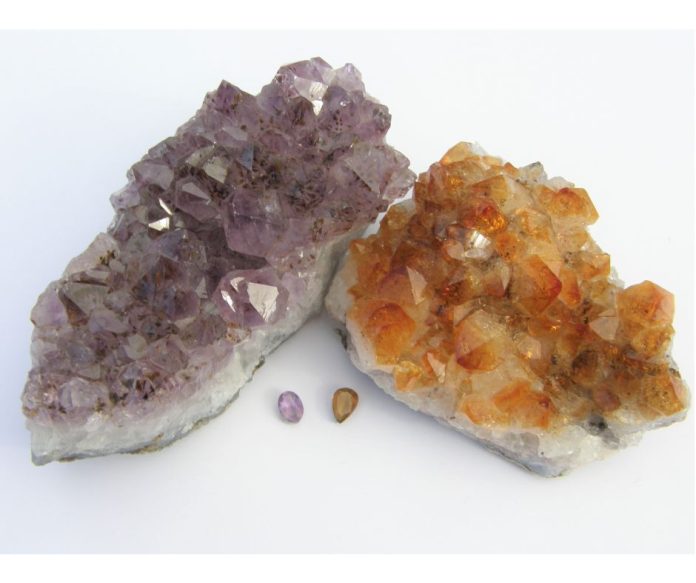
Gemstone enhancement includes the various treatments and processes performed on natural gemstones to improve their appearance, durability or overall value. Ever since gems attracted human eyes, we’ve developed methods to improve the color and quality of natural stones with synthetic treatments. Some gems are now grown synthetically and others are enhanced. All are accepted practices within the trade, so long as they are disclosed.
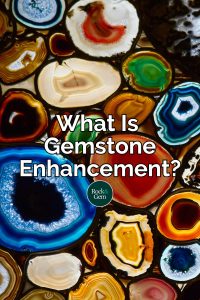
The Federal Trade Commission has disclosure rules but some argue they don’t go far enough. The following are four methods of synthetic gemstone creation, including how is synthetic quartz made and gemstone enhancement explained. Are such methods ethical or are they phony fakery? Read, then decide!
Growing Crystals
In the nineteenth century, Auguste Victor Louis Verneuil developed the powder flame fusion process. Using an apparatus the size of a room, Verneuil produced a ruby an inch long and a quarter-inch wide by combining a powder of aluminum oxide with chromium and dropping it down a tube with ignited hydrogen to form a drop-shaped boule.
The Verneuil process to grow crystals is still used today. Other techniques include the Czochralski melt growth, flux growth, hydrothermal growth and high-pressure piston chambers. Companies producing synthetic gems closely guard their methods. Why go to the expense and bother of crafting synthetic stones under such secrecy? Such stones serve a variety of purposes.
Not only might they grace expensive rings for jewelry, “perfect” crystals grown in a lab are essential for lasers, optics, and electronics, where natural imperfections cause problems. Plus, there are times when you need substances in abundance, like silicon carbide (carborundum) to crush for use as an abrasive. Other industrial uses include emery files, diamond drill bits and saw blades or ruby watch bearings. When crystals of precise specifications and/or abundance are needed, synthetic growth often is the way to go, and companies providing such materials patent their methods.
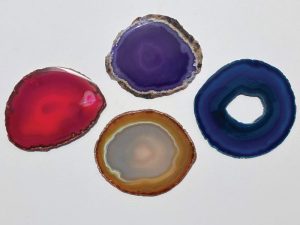
Are Synthetic Crystals Real or Fake?
To be clear, synthetic gems are not fake. Although not crafted by nature, they are real gems with the qualities that define natural stones. Aluminum oxide is aluminum oxide. Whether crafted by nature or humans, it gives us corundum (rubies and sapphires). Once faceted or cabbed, it takes an expert to differentiate lab-grown versus natural ruby. Sometimes even experts can’t tell. That’s because such gems are real gems!
The main difference? Scarcity and perfection. Natural gems with perfect structure and clarity are rare and expensive to mine. Perfect gems can be produced synthetically in quantity quickly and at far less expense. Thus, they should be less expensive than natural stones. Right?
Some who make synthetic gemstones include markers to distinguish their lab-grown from natural stones. One ruby producer introduces an element that makes her synthetic rubies glow a distinct color under ultraviolet light. Such are the ethics of some in the industry that occasional dealers offer triple her asking price if only she removes the marker. There’s nothing wrong with synthetic gems so long as they are honestly advertised.
How to Tell the Difference Between Natural and Synthetic GemsThe lack of imperfection usually, but not always, screams synthetic. Under a jeweler’s loupe, imperfections differentiate natural from synthetic stones. How so? • Look for flaws—or the lack thereof. Natural stones usually have flaws or inclusions. • Look for zoning. Natural stones often have growth lines and/or color zoning. |
Oiling, Fracture-Filling, and Dying
Certain gemstones, like emeralds, are notorious for fractures. Emeralds that undergo gemstone enhancement are often immersed in oils to hide micro-fractures reaching the surface. This practice continues and is considered acceptable although consumers should be aware that oils will dry out.
Turquoise is an icon of the American Southwest. Waxy robin-egg blue is especially prized. But turquoise is variable in color and consistency. It may be pale or chalky. Turquoise color is traditionally enhanced with dyes and sealed. Poor-quality turquoise has even been ground and mixed with resins and sold as real turquoise, which it is…to a degree.
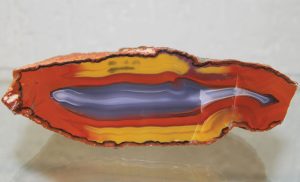
A more questionable gemstone enhancement takes inexpensive white rocks with veining and dyes them blue. The porous minerals howlite and magnesite have achieved dubious fame for the ease by which they are transformed into “turquoise.”
When you find turquoise beads going for unbelievably low prices, they often are strings of dyed howlite or magnesite. How to tell? Look for white spots since some portions of howlite and magnesite are less porous than the whole. Also, dye only penetrates the surface. If you break such a bead, you’ll find white beneath. Reputable dealers tell you if their turquoise beads are real or dyed look-alikes.
Dyeing Agates
Agate also is commonly dyed as a gemstone enhancement. In the 1490s, Germany’s Idar-Oberstein district unearthed garishly colorful banded agates. While prized worldwide, the supply played out. By the 1800s, German immigrants to Brazil discovered agates in their new homeland, but these were gray, yellow or brown. By this time, Germany had become an industrial powerhouse in the chemical industry. Immigrants to Brazil sent drab agates back to Germany where they were soaked in aniline dyes to produce garish colors previously found in Idar-Oberstein agates.
This is a nasty process. Agates are prepped by boiling in nitric acid, producing corrosive fumes. Agates then are baked at 450-650°F with more chemicals (iron nitrate, potassium ferricyanide, chromium trioxide, potassium chromate, sulphuric acid) followed by a cooling process. If a candy-colored agate looks artificial, it probably is. The color of a dyed agate is skin-deep and unstable. It eventually fades. Dyed agate slabs, particularly if strung as sun-catchers, will go from garish blue to drab gray under continual exposure to light.
The Colors of Dyed AgatesRED = Soaked in iron nitrate, then heated. GREEN = Soaked in potassium chromate, then heated and soaked in ammonium carbonate. BLUE = Soaked in potassium ferrocyanide followed by ferrous sulfate. BLACK = Soaked in sugar then sulfuric acid. |
Heat Treatment & Irradiation
Heating and irradiating minerals enhances or changes the color of a stone. Heat treatment remains the most common enhancement technique used with commercial gemstones. Compared with dying, heat treatment is permanent. Here’s how!
Heat treatment
Applying heat improves color and clarity of amethyst, aquamarine, tourmaline, topaz, sapphire, zircon, and more by dissolving gas, fluid, or mineral inclusions interfering with natural colors.
The result? A stone more intense in color or even a different color altogether.
In years past, people shielded themselves with bricks then blew air through bamboo tubes onto glowing charcoal laced with gemstones. Artisanal miners in India, Sri Lanka, and Southeast Asia still follow this practice, but more sophisticated methods enlist computer-controlled electric furnaces to monitor temperatures and times.
Milky Montana sapphires become rich hues of blue, yellow or pink. Indeed, most blue sapphires on the market have been heat-treated. The technique has been used for 2,000 years to change zircon from brown to golden-yellow or blue.
Heat treatment is commonly used for amethyst. Brazil is famous for vugs with purple amethyst. The deeper the purple, the more desirable. Thus, if a vug has pale amethyst, it may be heat-treated and changed to orange. This is sold at a higher price as rare citrine. Seldom is the buyer told heat treatment was involved.
Irradiation
While we react emotionally to the word radiation, radioactivity is all around us. It is a natural process that colors some stones. Radiation modifies how a crystal structure absorbs light, changing the color we see. For instance, white halite turns blue. Clear quartz with traces of aluminum becomes smoky quartz. People have used this knowledge to change common Arkansas quartz clusters into more valued jet-black smoky quartz. While natural radiation may take millions of years, the same effect is accomplished in hours within a lab.
Popular blue topaz is rare in nature where it is usually clear or brown. But lab-based heating and irradiation convert topaz blue. It is the single most important commercial use of artificially induced irradiation for the gemstone market. Per one source, “virtually every blue topaz sold is the product of irradiation.”
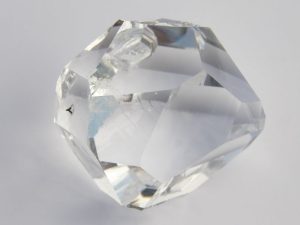
Pyro-Electric Bonding
Quartz easily bonds with other elements. A pyro-electric bonding process involves heating and using electric currents to bond one element to the surface of another. Because quartz is a prime candidate, this process is used to produce several varieties of “aura quartz.”
This is done in a vacuum chamber by “vapor deposition” or “electrostatic bonding.” Quartz, placed in a chamber, is heated to 800-900°C. Air is removed and precious metals are puffed in and permanently bond with the quartz. Only the surface of the quartz is covered and brilliant colors are the result of optical interference from ultra-thin metallic layers. This process, also called vacuum metalizing, began as an industrial process used to bond aluminum to the inside of glass headlights on vehicles.
Aura quartz crystals are sold at low prices to kids at gem shows or high prices to New Age mystics, often with no mention they are entirely artificial and have been enhanced with ultra-thin metallic layers.
Gemstone Enhancement: True Fakes & Phonies
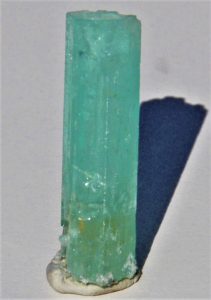
While these gemstone enhancements involve actual minerals and elements, there are true fakes on the market. Perhaps the most unusual is Fordite. While this may look like banded agate, it’s painted from decommissioned auto plants. Cars moved along rails and were spray painted. Different colors built up on the factory floor and a cottage industry emerged to pry paint residue and sell it as jewelry rough, which is even more expensive than actual gemstones.
While Fordite is a novelty and is sold as such, true fakes have been developed using dyes and resins. Faux malachite can be identified by its light weight and the color of the bands which include black. Bands in real malachite are all green—from darkest green to lightest.
Gemstone Enhancement: How Heat Changes Gemstone Colors• Green aquamarine turns blue. • Pale purple amethyst changes to yellow or orange “citrine.” • Milky or included sapphire turns to blue, yellow or pink. • Brown topaz becomes pink. |
This story about gemstone enhancement previously appeared in Rock & Gem magazine. Click here to subscribe. Story by Jim Brace-Thompson.















